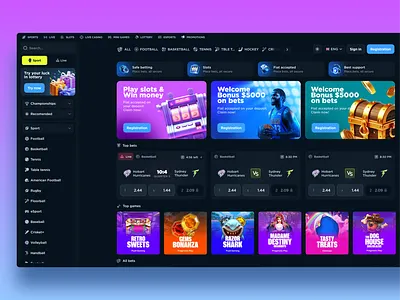Bedding Insights
Exploring the latest trends and tips in bedding and sleep comfort.
Betting Bliss: Discovering the Secrets of Sports Betting UX Patterns
Unlock the secrets of sports betting! Explore the winning UX patterns that enhance your betting experience and boost your profits.
Understanding User Preferences: Key UX Patterns in Sports Betting
Understanding user preferences is crucial for creating an effective sports betting platform. Analyzing key UX patterns can help developers design interfaces that cater to the needs of bettors. For instance, many users prefer personalized experiences that allow them to quickly access their favorite sports, teams, or betting types. Implementing features like customizable dashboards and tailored notifications can significantly enhance user satisfaction and retention. Furthermore, trends indicate that mobile accessibility is a top priority, with users increasingly favoring applications that provide seamless navigation and quick bet placement.
Another significant aspect of understanding user preferences in sports betting is the importance of visual appeal and intuitive design. Research shows that users are drawn to platforms with clean layouts and clear information hierarchy. Employing common UX patterns, such as progressive disclosure of information, allows users to easily digest complex betting data without feeling overwhelmed. Engaging elements like live betting notifications and interactive statistics can also enrich the user experience, making betting not just a transaction, but an engaging part of the sports viewing experience.

Counter-Strike is a popular tactical first-person shooter game where teams of terrorists and counter-terrorists compete to complete objectives. Players strategize and utilize various weapons to outsmart their opponents. For gamers interested in enhancing their experience, using a cloudbet promo code can provide exciting bonuses and rewards.
The Psychology of Betting: How UX Design Influences User Decision-Making
The intersection of psychology and betting is a fascinating field, particularly when considering how UX design plays a crucial role in shaping user behavior. Various psychological principles, such as *loss aversion* and *heuristics*, can significantly influence decision-making in betting environments. For instance, research suggests that users are more likely to engage in riskier bets when the interface emphasizes potential gains over losses. By utilizing techniques like color psychology, designers can create a sense of urgency or excitement, motivating users to make quick decisions. Additionally, the layout of information, including the use of clear calls to action and intuitive navigation, can steer users toward certain betting behaviors, making the decision-making process more seamless.
Moreover, the role of emotion cannot be overlooked in the context of betting. High-stakes gambling can evoke strong feelings of exhilaration or anxiety, and effective UX design capitalizes on these emotional triggers. For example, the use of animations, sounds, and engaging graphics can enhance the user's immersive experience, making them feel invested in the outcome. It is here that designers must balance excitement with user responsibility to ensure that the experience remains enjoyable and does not lead to compulsive behavior. Ultimately, understanding the psychological underpinnings of user interaction with betting platforms, paired with strategic UX design, can facilitate more informed decision-making while enhancing user engagement.
What Makes a Winning Sports Betting Experience? Top UX Tips and Tricks
Creating a winning sports betting experience hinges significantly on user experience (UX) design. A well-structured interface can make navigation intuitive, ensuring users find their favorite sports and events with ease. Key elements include responsive design that adapts to various devices, reducing frustration for users on mobile or tablet. Additionally, incorporating easy-to-read odds and simplifying the betting process with clear calls to action can enhance user satisfaction. Prioritizing loading speed is essential as slow websites can lead to user drop-off, impacting overall engagement and success rates.
Another critical aspect is providing comprehensive information and resources for bettors. This can be achieved by including educational content on betting strategies, tips, and updates on teams and players. Implementing user feedback mechanisms—such as ratings and reviews—can also guide improvements and build trust within the community. Furthermore, consider enhancing personalization options, allowing users to tailor their experience based on their preferences, which can significantly increase user retention and satisfaction. By focusing on these UX tips and tricks, sports betting platforms can cultivate a thriving, loyal user base.